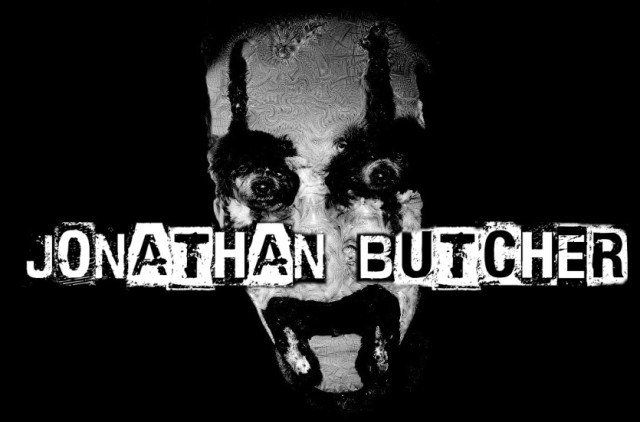

Jonathan Butcher is a veritable powerhouse of creativity. His work isn’t afraid to push the boundaries; to hurt and repel. It can be fiercely uncompromising, ball-achingly cold, horrifically disturbing, and gut-churningly sick. But this is not extreme horror for the simple sake of disgusting or disturbing its audience. There’s a hell of a lot more to his work than that…albeit, sometimes it can just be an old joke that’s followed him through life!
With Butcher’s novella ‘What Good Girls Do’ (2017) currently ‘Book of the Month’ over at the ‘Splatter Club’, what better time to catch up with the man himself to explore the catacombs of the horrors lurking behind his stories…




DLS – Many thanks for agreeing to be interviewed on DLS Reviews.
I understand your novella ‘What Good Girls Do’ (2017) is currently ‘Book of the Month’ over at the ‘Splatter Club’ – an online book club for extreme literature. So beginning with that book seems like an appropriate place to start the interview. For those who haven’t yet read this delightful tale yet, I guess the best thing would be if you could provide a brief overview of what to expect from the story…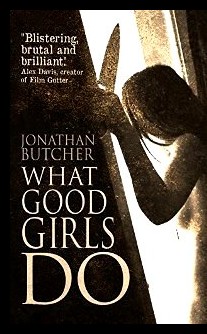
JB – Okay, cool. And thanks for interviewing me! It’s a novella about an unnamed girl who has never left the basement in which she has always been imprisoned. In that room she has been abused and mistreated relentlessly for as long as she can remember, and her entire viewpoint has been shaped by these experiences. The story takes place on the first day she ever leaves her room, and explores her first experiences with the outside world.
DLS - Can you tell us a little about your inspiration and motivation for writing ‘What Good Girls Do’ (2017). Let’s be honest, it’s a pretty difficult read, even for someone who’s quite accustomed to extreme horror. What made you want to write such a thing?
JB – I don’t usually write what I would call “extreme horror”. I like some stories from that genre, but only those that I feel have something to say. I never planned to write something as cold and unpleasant as What Good Girls Do, but it was a story that I needed to tell.
For whatever reason, throughout my life, people and friends (and occasionally even strangers) have opened up to me quite quickly, which means that I often learn things about them that others might not. It’s difficult to discuss this book without my answers being as dark as the story itself, but here goes. As I’ve gotten older, I’ve become concerned with how often I have heard tales of real-life sexual abuse. Much of the time it seems to happen at the hands of someone in a position of trust, and while I thankfully have never experienced it, too many people that I care about have. It’s a theme that has featured on the sidelines of some of my previous works, but with What Good Girls Do I decided to tackle it head on.
DLS – Did you find it difficult to write the harder hitting passages of the story? And afterwards, was it difficult to switch off from the vileness that must have been swirling around in your head?
JB – It wasn’t a fun few months, but the process was extremely satisfying because the story almost wrote itself. I’ve never been afraid to write graphically violent scenes, but because the story is one of such misery and ugly truths it was a relief when I no longer had to think about it on a daily basis. In a sense, it’s more about What Bad Men Do than What Good Girls Do, but that title wouldn’t have carried quite the same weight or sense of irony!
DLS – Prior to writing the novella, did you do much research on similar real-life stories, such as the anics of Joseph Fritzl or Wolfgang Prikopil?
JB – I was shocked by cases such as those – the Frizl case in particular inspired the tale’s scenario – but my main sources of inspiration came from films such as The Woman, Bad Boy Bubby, Martyrs, and Baise-Moi. This last film is a similar flick to the fictional movie that my character Girl finds amongst her porn collection, and which sets the events of the book into motion.
DLS – The story is written through two first-person perspectives, that of the ‘Girl’, as well as that of her next-door neighbour. Did it take long to decide on this particular approach to telling the story, and do you feel using such a perspective enhanced the harrowing nature of it?
JB – The first thing I wrote was Girl’s opening three scenes as one big block of prose. Girl’s voice is basically an exaggerated version of the voice of what in the fetish community is known as a “Babygirl”, meaning a submissive who dresses young and who will generally seek out a Daddy Dom(s). It’s linked with fetishised age-play, and I took this consensual but controversial kink and placed it within the framework of an abusive relationship. And yes, I wrote in first-person-perspective purposefully, because I wanted to remove anything remotely titillating from the story. That’s why, instead of making the reader a voyeur watching the perpetrator, I aimed to put them into the head of the person being abused. This wasn’t something I thought consciously about. It came about quite naturally.
DLS – ‘What Good Girls Do’ (2017) is a gut-churningly fast and punchy read, that thunders along with such a building momentum it’s hard to stop reading. Did it take a lot of work, drafting and redrafting to get the story so ferociously on point all the time? Do you consciously examine the flow and pacing of a story as you write it?
JB – To be honest, of all the longer-form stories I’ve written, What Good Girls Do took the shortest time. The story just poured out of me, like it had been waiting for the right moment to be written and was at last ready to be purged. With most longer-form stories I have to cut out a lot of fat and unnecessary rambling when I start redrafting, but What Good Girls Do barely changed from the first draft to the third and final draft.
DLS – One aspect in ‘What Good Girls Do’ (2017) that really stands out, well aside from the uncompromising brutality of the tale, is the attention to detail that you’ve managed to capture. It’s an aspect that makes the story so much more hauntingly believable. How did you manage to achieve this? Did you almost force yourself to imagine being ‘The Girl’ and try to perceive how her mind (and body) must have been affected having lived such a hellish life? Did you do any research (not first-hand I hope) on the physical and psychological effects of such a life?
JB – As I mentioned, I’ve known people who have suffered and I’ve seen first-hand the impact that such experiences have on a person. Having been close to people like this, it didn’t take long to put together a character whose entire viewpoint was constructed by their own suffering. The toughest part, and I still don’t know if I managed to pull it off, was imagining how she would comprehend all of the new things she sees in the outside world, and how she would relate them all to the very limited number of things she knew from back inside her room.
DLS – Without giving the ending of the story away to anyone who hasn’t read the story, I’d be keen to know if when writing the tale you had any alternative ideas for how you’d conclude the book? Or was it always going to end in that way?
JB – The way it ends is actually more restrained than how it was originally going to end, though still similar in tone. Some people have an issue with the ending, thinking that the tone doesn’t suit the rest of the story, but to me it felt inevitable. One of the main points of the story is that bad experiences always leave their mark, and when they’re as extreme as those in the book, they will change a person. PTSD is cruel, unpredictable, and often destructive, and it isn’t something that a person just “gets over”.
DLS – What has the reaction to ‘What Good Girls Do’ (2017) been like? After all, it’s certainly not a story for everyone!
JB – My biggest relief is that no one has accused it of being exploitative or in any way titillating. I was terrified that people were going to read it and assume it to be some kind of sick fantasy on my part. It’s had a good reception so far, but it’s definitely too much for some people. I have personally witnessed the opening lines ruin someone’s day. Another person told me that when they read the first page they were sick in their mouth, and my publisher saw someone break down in tears because of the first few lines. I’m not saying I’m proud of that, but stories like these certainly tell me that I got something right!
DLS – Did you have much input or influence over the novella’s cover? It’s probably fair to say it doesn’t really portray the extremity of the story within – but it’s nevertheless still very fitting for the tale.
JB – The cover image was my idea, as I think it suits the melancholy that sits at the story’s heart. It was a shot taken by my girlfriend, and posed for by a brave friend. The original version of the cover was the colour of molten fire and reminded me more of an exploitation flick. It was cool, but I wanted a different feel and I think we achieved that.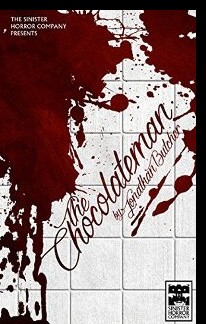 DLS – Moving away from ‘What Good Girls Do’ (2017), The Sinister Horror Company also rereleased your short story ‘The Chocolateman’ (2017) as a limited edition signed and numbered chapbook. I recently read and reviewed this delightful little tale, along with the accompanying Afterword and Photo Galleries within it. For those that haven’t had the pleasure of reading this story yet, think ‘Candyman’ (1992) only drenched in shit! So Jonathan, again I have to ask, what sort of reaction have you had from this, let’s be honest, pretty damn fucked up read?
DLS – Moving away from ‘What Good Girls Do’ (2017), The Sinister Horror Company also rereleased your short story ‘The Chocolateman’ (2017) as a limited edition signed and numbered chapbook. I recently read and reviewed this delightful little tale, along with the accompanying Afterword and Photo Galleries within it. For those that haven’t had the pleasure of reading this story yet, think ‘Candyman’ (1992) only drenched in shit! So Jonathan, again I have to ask, what sort of reaction have you had from this, let’s be honest, pretty damn fucked up read?
JB – It’s strange to think that this stupid character that I created with a couple of mates about 10 years ago led to a publisher releasing my first novella. Most people have reacted well to it, but the best came just after it appeared in a chocolate-themed anthology entitled, Death By Chocolate. Justin Park, of the Sinister Horror Company, had a story in the book, and when he read The Chocolateman he immediately got in touch to tell me how much he liked it. We have been hanging out and collaborating ever since.
DLS – The story of ‘The Chocolateman’ (2017) is centred on the shit-demon Kreb Sabertooth. I absolutely love the history and mythos behind this character. Furthermore, I understand even before the publication of ‘The Chocolateman’ Kreb had already had quite a life in amateur short films and photos. Do you have any other plans for Kreb? I’m sure I’m not the only one who’d love to see the depraved little bastard return.
JB – Kreb will be popping his filthy head out of his hole again later this year in an as-yet-unannounced project, but my greatest hope is that he appears one day in a film. I have a 30-minute screenplay written, which is basically a splatter film but featuring faeces instead of blood. It’s ready to be filmed, so all I need is to find a director brave enough and sick enough to make it happen!
DLS – Can you tell us a little about your experience with working with The Sinister Horror Company who not only published ‘What Good Girls Do’ (2017), but also ‘The Chocolateman’ (2017)?
JB – It’s been a pleasure. The SHC are so passionate and hard-working when it comes to horror, and if my experience is anything to go by they treat their authors with a lot of respect. They deserve respect and, dare I say, awards, for the efforts and work they put in. And it’s not even just books that they make – I’ve already had two of my characters made into Top Trumps cards because of the SHC, and I have something I could imagine you in particular are going to LOVE due to feature in their upcoming annual.
DLS – I understand you’ve recently released an anthology entitled ‘Visions From The Void’ which contains twelve short stories by a variety of horror authors, inspired by twelve different black & white op art designs created by your father – Les Butcher. What an incredible idea! Can you tell us a little about what we can expect from the anthology, what the authors involved have said about the project, and what your father made of the book?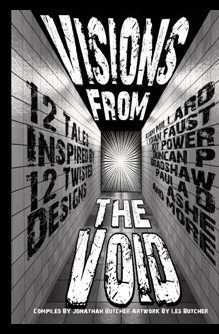
JB – My dad has almost always made stark, black-and-white op-art designs, but he’s never been the kind of person to try and promote his own work. I’ve always loved his art, and a while ago I came up with the idea of using his pictures to inspire some short stories. Seeing as I’ve had the privilege of meeting some excellent, talented authors since starting to get my own work published, it wasn’t difficult coming up with a list of people I wanted to contribute to the book. Thankfully, some of my favourite indie authors were excited by the concept, and managed to throw themselves head-first into the book while telling a hugely varied range of tales. Amongst the tales was a story that has become my favourite short horror that I’ve read in years! And yes, my dad loves his book, and takes every opportunity he can to tell me so – especially seeing as my own contribution to the book stars myself and my dad.
DLS – I see the book found a home at Matthew Cash’s Burdizzo Books. Did you find it difficult to sell your idea to a publisher, and what has your experience been like working with Burdizzo Books?
JB – I’ve been friends with Matthew Cash for a couple of years now – since he edited Death By Chocolate and gave a home to the Chocolateman, in fact. I’m happy to see that he and his partner-in-crime Emma Dehaney are making a name for themselves with Burdizzo Books, and I was even more happy to see how excited they were by my idea for Visions from the Void. After seeing how much freedom they gave me to run with this concept, how thorough Emma’s editing is, and how far Matthew’s awesome cover-creating skills have come, I’m very proud to be working with such talented motherflippers. There might even be a follow-up, but that remains to be seen.
DLS – Speaking of Matthew Cash, you co-wrote a novel with him entitled ‘Demon Thingy’ (2017). What was it like co-writing such a bizarre, over-the-top tongue-in-cheek horror comedy with someone else, and did the novel come out as you originally envisioned it?
JB – Yeah, that’s the stupidest thing I’ve ever written, and I love it! Matthew and I have similarly “wrong” senses of humour, so it was almost inevitable that we’d write something together at some point. I wrote an opening scene and we basically riffed it from there, gradually adding more and more silly themes and ideas until we had enough for a story. At that point we had to rein ourselves in, and I plotted out the rest of story and we finished it together. In a way, writing a ridiculous story about mutant arses on legs, senile devil worshippers, and a wizard who eats through his anus and poops through his mouth was my therapy after writing What Good Girls Do! I’m looking forward to doing Demon Thingy – Book Two at some point.
DLS – I understand you’ve recently released your first full length novel, entitled ‘The Children At The Bottom Of The Gardden’ (2018). Can you tell us a little about what to expect from the novel, and your inspiration behind it?
JB – I started writing it over ten years ago, and it’s a relief to finally get it released. It’s a horror/drama based in a coastal resort that is basically an urban version of my home town, Newquay, and I think it features the most memorable characters I’ve ever come up with, as well as some of my best writing. There’s some questionable scenes in there, but compared to What Good Girls Do it’s a walk in the park. I’d tried to write a couple of novels before working on ...Gardden, but this was the first one where I stopped trying to create “art” and just wrote about a cavalcade of weird stuff that interests me. Gangsters, drugs, and unnameable entities – what more could you want?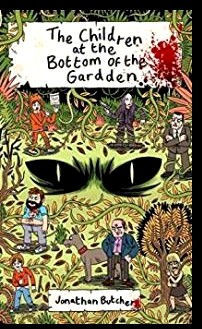 DLS – ‘The Children At The Bottom Of The Gardden’ (2018) sports some great cover artwork. Can you tell us a little about your involvement with its creation, who’s behind it, and the concept behind the art?
DLS – ‘The Children At The Bottom Of The Gardden’ (2018) sports some great cover artwork. Can you tell us a little about your involvement with its creation, who’s behind it, and the concept behind the art?
JB – I’ve known a talented artist by the name of Jack Teagle for many years, and because ...Gardden is a labour of love for me, I wanted the right person to draw the cover for me. Jack was great to work with, and very receptive to all my (no doubt annoying) requests for changes. The cover shows my 7 main characters all metaphorically entangled in the strange, ghostly garden that is luring them throughout the book. Having the cover looking as good as I think it does, as well as having unique fonts for each character’s scenes, is a real thrill for me.
DLS – A little while back you joined Jim Mcleod’s esteemed team over at Ginger Nuts Of Horror, providing us with such things as your favourite utterly tasteless movies. How have you found being part of the GNOH family and have you any plans for any more features on the website?
JB – It’s been great! I just wish I had more time to contribute. Jim Mcleod has been nothing but a support for me ever since I started writing for the site, and the amount of time and effort he puts into the Ginger Nuts of Horror deserves recognition. In fact, I gave him the first ever printed copy of ...Gardden as a way to thank him for the time he puts into the website and for always being a good, well-informed, friendly contact I’m looking forward to finally meeting him in the flesh and sinking a few pints at some point.
DLS – The last time I saw you was at the 2017 Bristol Horror Con, where you were on a panel (alongside John Llewellyn Probert and Hellbound Media’s Mark Adams) discussing contemporary horror movies and their future. How did you find the experience and have you done any more panels since?
JB – I loved chatting on that panel, because I love talking horror with anyone who’ll listen. I haven’t done any more since, but I’d be more than happy to.
DLS – Speaking of the Bristol Horror Con, it was there that I first watched your short film ‘Stuck’. If you don’t mind, I think I’ll let you describe the basic ‘plot’ of this wondrous piece of cinematography. And once you’ve done that, please, please, please do tell us where you got your idea for the film from?
JB – I’ll actually be sharing that with (hopefully) some new horror fans at the Splatter Club later this month. The idea came from watching the horror film Frozen (no, not the Disney), and thinking that it was such a ludicrous pile of crap that I should do my own exaggerated parody. Frozen is about three characters getting stuck on a ski lift 20 metres in the air for several days, and being faced with the choice of either freezing to death or escaping somehow. The dumbest moment for me was when the lead female, who had already witnessed her boyfriend shattering his legs and being eaten by wolves, started weeping when she had to take a pee, as if it was the ultimate poignant moment of tragedy. That’s why I wrote a script that featured two characters in a similarly life-threatening scenario, but instead of being Frozen high up in the air, one of them was Stuck in the other’s butt. It’s high-brow stuff, as you can imagine, but I think it’s funny. That’s all that matters to me.
DLS – I’m beginning to see you as a kind of British Duncan Ralston. And I mean that as a huge compliment. Have you read any of his work? And if so, what do you make of it?
JB – That’s a huge, huge compliment. I read Ralston’s WOOM just as I was starting to explore some indie horror titles a few years back. Until then, nothing had impressed me, but then that book blew my fucking mind! Anyone who considers themselves a fan of extreme horror should read WOOM, because it is nigh-on a miniature masterpiece. I’ve read most of his other books since then, and he’s also a funny guy who I bullshit with and talk to on social media. So yeah, no problem with that comparison at all, man.
DLS – You’re clearly a very creative individual. I understand you were the vocalist in a death metal band (or was it black metal?), you’ve created short films and are now writing fucked-up horror fiction? Outside of writing, have you any plans for any other creative projects?
JB – I’ve been in so many music projects, and most of them have had stupid names. Wait, did I say stupid? I meant deadly serious. I’m a vocalist, and the most recent band I was involved with was Vomit Coffin, a brutal old-school death metal band that actually toured England last year. Other than that, my proudest music work has been writing the lyrics and performing the vocals with my mate Jack Bibby for the death/black/prog project, Scrotonic Discharge. Together, we wrote a full concept album called Of Betrayal, and a Bastard that told an alternate version of the Christian myth.
Then there was Cuntfaced, which was a public prank band, where we would go to an Open Mic night where everyone was playing nice chilled-out acoustic or rock song covers, and then we’d go up on stage and ruin everything. We’d dress up in the dumbest clothes we possibly could and I’d name the most offensive or silliest song name I could think of (examples: Doghammer, It’s Not Gay if it’s Your Best Mate, and Your Mum on a Date with a Holocaust Denier) and we’d make up an awful song on the spot. That’s probably the most fun I’ve ever had, and there’s a documentary as well as full sets on YouTube.
DLS – To finish up with, in these interviews I like to ask what your top five all time novels are. Mind giving us yours?
JB – That’s tough, and it will probably change pretty often. Let’s say Filth by Irvine Welsh, I, Lucifer by Glen Duncan, Uzumaki by Junji Ito – those are definites. But then it’s tough to narrow down between classic stuff like A Clockwork Orange, 1984, and maybe American Psycho, and I also love The Road by Cormac McCarthy, WOOM by Duncan Ralston, and Watchmen by Alan Moore. That answer will have to do.
DLS - Many thanks for taking the time out to answer all of those questions Jonathan, it’s been an absolute pleasure.
© DLS Reviews
You can see in-depth reviews of Jonathan Butcher’s work here:
- The Chocolateman (2017)
- What Good Girls Do (2017)
- The Children At The Bottom Of The Gardden (2018)

